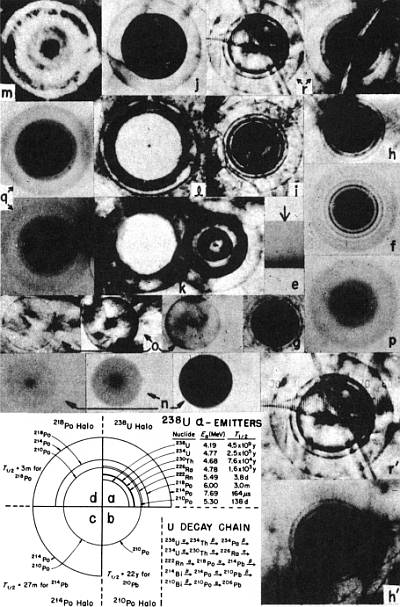|
Earth Science Associates |
|||||||||
|
||||||||||
|
Creation's Tiny Mystery |
||||||||||
|
|
< Prev T of C ... 12 13 14 15 Epi. Cat. App. Ref. Cred. Next > Radiohalos in a Radiochronological and Cosmological PerspectiveScience, vol. 184, pp. 62-66, April 5, 1974.Abstract. New photographic evidence, data on halo ring sizes, and x-ray fluorescence analyses provide unambiguous evidence that polonium halos exist as a separate and distinct class apart from uranium halos. Because of the short half-lives of the polonium isotopes involved, it is not clear how polonium halos may be explained on the basis of currently accepted cosmological models of Earth formation. I have examined some 105 or more radiohalos, mainly from Precambrian granites and pegmatites located in several continents. In addition to U and Th halos, originally studied (1, 2) for information on the constancy of the α-decay energy Eα and the decay constant λ, I have discussed X halos (2, 3), dwarf halos (3), and giant halos (4), and explained how these remain prime candidates for identifying unknown α-radioactivity and, not impossibly, unknown elements as well. I have also reported (5) on a class of halos which had been tentatively attributed (6, 7) to the α-decay of 210Po, 214Po, and 218Po. Earlier investigators (2, 7-10), possessing only a sparse collection of Po halos, at times confused them with U halos or invented spurious types such as "emanation" halos (2) or "actinium" halos (8) to account for them. (Figure 1, a to d, is a schematic comparison of U and Po halo types with ring radii drawn proportional to the respective ranges of α-particles in air.) To explain Po halos, Henderson (7) postulated a slow accumulation of Po isotopes (or their respective β-decay precursors) from U daughter product activity. I demonstrated that this secondary accumulation hypothesis was untenable and showed, using the ion microprobe (3), that Po halo radiocenters (or inclusions) exhibit anomalously high 206Pb/207Pb isotope ratios which are a necessary consequence of Po α-decay to 206Pb. Recently, these ion microprobe results have been questioned, Henderson's results misinterpreted, Po halos considered [p. 240] to be only U halos, and allusions made to the geological difficulties that Po halos would present if they were real (11) [see (12) for comments]. Admittedly, compared to ordinary Pb types, the Pb isotope ratios of Po halos are unusual, but new ion microprobe analyses have confirmed (13) my earlier results (3). It is also apparent that Po halos do pose contradictions to currently held views of Earth history. For example, there is first the problem of how isotopic separation of several Po isotopes [or their β-decay precursors (13)] could have occurred naturally. Second, a straightforward explanation of 218Po halos implies that the 1-μm radiocenters of very dark halos of this type initially contained as many as 5 × l09 atoms (a concentration of more than 50 percent) of the isotope 218Po (half-life, 3 minutes), a problem that almost defies reason. A further necessary consequence, that such Po halos could have formed only if the host rocks underwent a rapid crystallization, renders exceedingly difficult, in my estimation, the prospect of explaining these halos by physical laws as presently understood. In brief, Po halos are an enigma, and their ring structure as well as other distinguishing characteristics need to be made abundantly clear. In order to ascertain the Eα corresponding to a specific halo radius, I have produced a new series of standard sizes against which halo radii may be compared without relying on estimates derived from ranges of α-particles in air. Standard sizes may be prepared by irradiation of halo-bearing mineral samples with 4He ions (4); the coloration bands thus produced show varying sizes (as measured from edge to coloration extinction) which are dependent on energy, total dose, and dose rate, the latter two factors not being accounted for in other comparative methods. I made more than 350 irradiations 1 to 104 seconds in duration using 4He ions with energies ranging from 1 to 15 Mev, on over 40 samples of biotite, fluorite, and cordierite (14). Selecting the band sizes which correspond to the energies of the 238U α-emitters (see Table 1) permits a direct comparison with new as well as previous (1, 9, 10, 15) U halo measurements in biotite, fluorite, and cordierite. Figure 1e shows a coloration band in biotite produced by 7.7-Mev 4He ions, and Fig. 2a shows a densitometer profile of Fig. 1e.
[p. 241]
Doc.: T of C ... #1 #2 #3 #4 #5 #6 #7 #8 #9 ... < Prev T of C ... 12 13 14 15 Epi. Cat. App. Ref. Cred. Next > |
|
|||||||
|
|
||||||||||
|
||||||||||
|
Earth Science Associates
|
||||||||||



